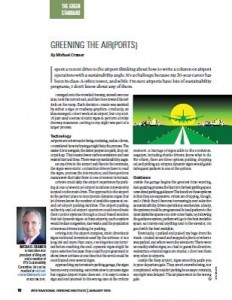I spent a recent drive to the airport thinking about how to write a column on airport operations with a sustainability angle. It’s a challenge because my 30-year career has been in class-A office tower, and while I’m sure airports have lots of sustainability programs, I don’t know about any of them.
I merged onto the crowded freeway, moved over one lane, took the correct exit, and then bore toward the left fork on the ramp. Each decision I made was assisted by either a sign or roadway graphics. Gradually, an idea emerged: I don’t work at an airport, but I fly a lot. I’d just used a series of static signs to perform a tricky freeway maneuver. Getting to my flight was part of a larger process.
Technology
Airports are notorious for being confusing, and as I drove, I considered how technology might help the process. The easier it is to navigate, the faster people can park, drop off, or pick up. That means fewer carbon emissions and less wasted fuel and time. There was my sustainability angle.
On my drive to the airport and then to the terminals, the signs were static. Unfamiliar drivers have to read the signs, process the information, and then perform maneuvers that take them to one of several terminals.
Drivers could skip the airport experience by parking at one of several off-airport locations conveniently located on the main drive. The approach to the airport is the perfect place to incorporate dynamic signs that let drivers know the number of available spaces at on- and off-airport parking facilities. The airport parking authority and off-airport operators could coordinate their control systems through a cloud-based solution that fed dynamic signs. At busy airports, such a system would reduce congestion, fuel waste, and the population of nervous drivers looking for parking.
Driving into the airport complex, static directional signs indicated terminals used by the airlines. It is a long list and more than once, I’ve forgotten my terminal before reaching the end. Dynamic signs might be more effective because they could be programmed to show fewer airlines at one time but the scroll could be coordinated over several signs.
Approaching my terminal’s parking garage, the signs become very confusing. Motorists slow to process signs but regular airport traffic does not. It is easy to miss a sign and find yourself in the wrong lane at the critical moment. A barrage of signs adds to the confusion. Regulars, including shuttle drivers, know what to do. For others, there are three options: parking, dropping off, and picking up. Simpler, dynamic signs would guide infrequent parkers to one of the options.
Guidance
Inside the garage begins the greatest time-wasting, fuel-guzzling process: the hunt for the best parking space. How about parking guidance? The knock on these systems is that they are expensive. Prices are dropping, though, and I think they’ll become increasingly cost effective as sustainability drives operational efficiencies. Ideally, the systems could be programmed to lead parkers to the most desirable spaces on a first-come basis. By following the guidance system, parkers will go to the best available space. As I rarely find anything next to the elevator, I’m good with the best available.
Eventually, I parked and pulled my bags from the trunk. I looked around and snapped a photo of where I was parked. But where were the elevators? There were no readily visible signs, so I had to guess the direction. Pedestrian-oriented signs are crucial. I don’t see them very often in airports.
Inside the busy airport, signs smoothly guide you to your departure gate. They aren’t overwhelming, nor complicated. Why couldn’t parking be as easy? Ironically, my flight was delayed. The airplane went to the wrong gate.
Michael Cramer is executive vice president of Winpark and a member of IPI’s Sustainability Committee. He can be reached at michael.cramer@winpark.com or 832.786.3741.
TPP-2015-01-Greening the Air(ports)

